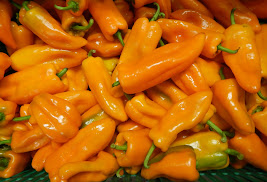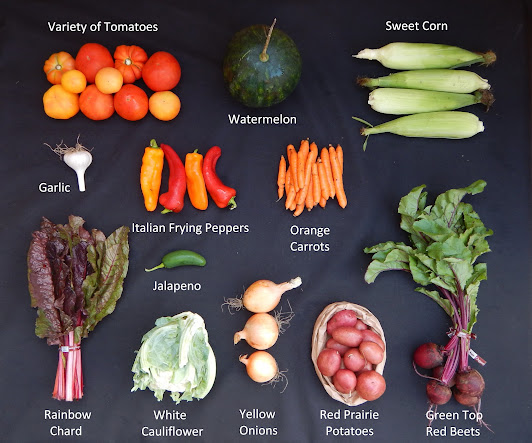Cooking With This Week's Box
Red and/or Orange Italian Frying Peppers:
Yellow Onions:
.jpg) |
| Photo from crunchycreamysweet.com |
Red Prairie Potatoes:
Variety Bag of Tomatoes:
Sweet Corn:
Red Seedless Watermelon:
White, Purple or Yellow Cauliflower or Broccoli Romanesco or Broccoli:
.jpg) |
| Photo from delish.com |
Jalapeño Pepper:
Porcelain Garlic:
Green Top Red Beets:
Rainbow Chard or Broccoli Raab:
Hello!
This week we have a burst of color in the box with sweet peppers! Peppers are one of my favorite crops and the ways you can incorporate them into meals and recipes are endless. This week’s featured recipe is very simple, but make sure you use good ingredients as this is the factor that makes this recipe shine. This recipe for Penne Pasta with Roasted Peppers and Almonds is very quick. While you boil the water and cook the pasta you can roast the peppers. Serve it on its own as a simple, light pasta dish or serve it alongside grilled beef, fish, or chicken. I also included links to two of my favorite sweet pepper recipes from the past, Sweet Pepper and Cheddar Clafoutis and Creamy Roasted Sweet Pepper Dressing. This dip is nice to have on hand. I use it to dip vegetables in, such as carrot sticks, but I also use it as a sauce on a variety of things including sandwiches and wraps.
I included several recipe collections for you this week to expand the possibilities. If you’re looking for ways to use the pile of tomatoes this week, check out 17 Ways To Build a Better Tomato Sandwich. If you receive broccoli raab and do not know what to do with it, check out 14 Broccoli Raab Recipes We’re Not Bitter About. And lastly, we don’t want those beet greens to go to waste, so check out this recipe entitled, 15 Ways to Eat Beet Greens (And Why You Should).
I also pulled up a few French classic recipes. Check out this Basque Piperade (Spicy Tomato-Pepper Sauce) or Pommes Boulangére (French Layered Potato and Onion Bake). While the names sound much more flashy in French, they are really quite simple preparations.
We have just a few more weeks of summer remaining! Keep your fingers crossed that we may continue to pick tomatoes for a few weeks, and I’m looking forward to just a little more sweet corn before the season is over. Pretty soon we’ll be harvesting leeks to go along with the celeriac, and we’ll be sending more cabbage. Of course, it’s almost time to start eating winter squash and just a few more weeks until we dig sweet potatoes!
Have a great week and enjoy all your delicious late summer creations!
-Chef Andrea
Vegetable Feature: Sweet Peppers
by Andrea Yoder
.jpg) |
| Mini Sweet Peppers |
 |
| Ukraine Peppers |
We also grow mini sweet peppers which are our all-time favorite sweet variety. While there are many snack peppers available in the marketplace today, we believe our peppers are more flavorful than commercial seed varieties. We’ve been saving our own seed for well over 15 years and our variety is not just carefully selected, but also well adapted to our area.
 |
| Orange Italian Frying Peppers |
While pepper season usually lasts several weeks, peppers are one of the easiest vegetables to preserve and it's worth putting some away to use throughout the winter. I use them quite often in winter stir-fries, as a pizza topping, added to soups and stews, and scrambled eggs, etc. Even if I am limited on time, I know I can always successfully freeze peppers as they do not need to be cooked before freezing. At a minimum, freezing peppers requires the time it takes to wash the pepper and put it in a bag. If I have a little extra time, and to save some freezer space, I’ll actually remove the stem and seeds and cut them into smaller pieces. Really, it’s that simple and you’ll really appreciate having them in the dead of winter!
Peppers are high in vitamins A & C as well as a whole host of other phytonutrients, so munching on a sweet pepper also has nutritive benefits. As far as storage goes, peppers are best held at a warmer temperature of 45-60 degrees. We recognize very few homes have this perfect storage environment, so we recommend you do your best. Personally, I choose to store them at room temperature. If you choose to put them in the refrigerator, I’d encourage you to use them within a few days as they can get cold injury with prolonged time at cold temperatures. Sometimes my peppers start to dehydrate and get soft and wrinkly. This does not mean the pepper is bad, it may have just lost some moisture. If this happens to you, don’t throw it out, rather use it in a cooked preparation such as soup or if you want to use it raw, do so to make a pepper puree or pepper sauce.
Penne Pasta with Roasted Red Peppers and Almonds
Yield: 4 servings
¾ pound penne pasta
4 colored sweet peppers, halved and seeded*
¾ cup pitted kalamata olives
½ cup coarsely chopped roasted almonds
¼ cup extra-virgin olive oil
1 Tbsp fresh thyme leaves
Salt and black pepper, to taste
- Cook the pasta according to the package directions. Reserve ½ cup of the cooking water; drain the pasta and return it to the pot.
- Meanwhile, heat broiler. Place the peppers, skin-side up, on a baking sheet and broil until blackened, 8-10 minutes. When the peppers are cool enough to handle, scrape away the blackened skins with a knife and discard. Cut the flesh into 1-inch pieces.
- Add the peppers, olives, almonds, olive oil, thyme, 2 Tbsp of the reserved cooking water, ½ tsp salt and ¼ tsp black pepper to the pasta and toss to combine. Add more cooking water if the pasta seems dry and adjust the seasoning to your liking. Serve while warm.
*Note: If you have a gas stove, you can leave the peppers whole and char them directly over a high flame, turning them frequently with tongs until they are blackened.
Recipe borrowed from Real Simple: Easy, Delicious Home Cooking.

No comments:
Post a Comment